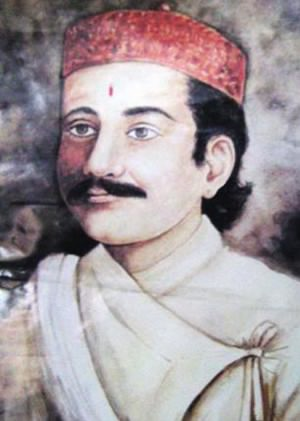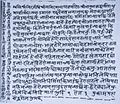Bhanubhakta Acharya facts for kids
Bhanubhakta Acharya (Nepali: भानुभक्त आचार्य) (1814—1868 CE) was a famous Nepali writer, poet, and translator. He is known as "Aadikabi," which means "the first poet" in Nepali. He became famous for translating the epic story Ramayana from Sanskrit into the Nepali language. This made the story available to many more people. His translation, called Bhanubhakta Ramayana, was first shared by people telling it to each other. Later, Motiram Bhatta published it as a book.
Quick facts for kids
Aadikabi
Bhanubhakta Acharya
|
|
|---|---|
| भानुभक्त आचार्य | |

A portrait of the poet
|
|
| Born | 13 July 1814 |
| Died | 1868 (aged 53–54) Setighat, Tanahun, Kingdom of Nepal
(present-day Nepal ) |
| Nationality | Nepalese |
| Occupation | Poet |
| Era | Bhanubhakta era |
|
Notable work
|
Bhanubhakta Ramayan, Ghansi |
| Parent(s) |
|
Contents
Early Life and Learning
Bhanubhakta Acharya was born on July 13, 1814. His birthplace was a village called Chundi Ramgha in Tanahun District, which was part of the Kingdom of Nepal. His parents were Dhananjaya Acharya and Dharmawati Acharya.
His father, Dhananjaya Acharya, worked as a government official. Bhanubhakta started learning Sanskrit at home from his grandfather. Later, he continued his education in Varanasi, a city in India.
Becoming a Writer
In Bhanubhakta's time, many languages in South Asia, including Nepali, were mostly spoken. There were not many written books or stories. Most written texts were in Sanskrit, which was a difficult language for most people to understand. Only a few educated people, like Brahmins, could read and understand Sanskrit religious books and stories.
Bhanubhakta started writing in the Nepali language. This helped make the language more popular. It also made his writings liked by the rulers of the time.
He wanted everyone to be able to read the famous story of Ramayana. Since most people did not understand Sanskrit, he decided to translate this long poem into Nepali. He kept the beautiful, song-like style of the original Ramayana. Scholars believe his translation kept the true feeling and meaning of the story.
Bhanubhakta did not learn about Western books or ideas. This made his writing truly Nepali. His works were simple but strong. They showed his religious beliefs, his love for simplicity, and the warmth of his country.
He came from a rich family, so he never had money problems. His life was quite ordinary until he met a grass cutter. This grass cutter wanted to do something good for society so people would remember him after he died. The grass cutter's words inspired Bhanubhakta to create something lasting for his community.
His Important Works
Bhanubhakta wrote two main masterpieces. One is the Bhanubhaktey Ramayan. The other is a letter he wrote as a poem to the Prime Minister. He wrote this letter while he was in prison.
He was sent to prison because of a misunderstanding with some papers he signed. While in prison, he became sick. He was promised freedom, but his case was not heard. So, he wrote a poem asking the Prime Minister to free him. This poem became one of his great works. Not only did he win his freedom with this poem, but he also received money.
When he passed away in 1868, Bhanubhakta did not know how famous he would become. His writings were not published during his lifetime. He died without getting credit for his important work.
His works were finally published in 1887 by Motiram Bhatta. Motiram Bhatta found Bhanubhakta's original writings and took them to Benaras, India, to be printed. One of Bhanubhakta's poems is well-known for its colorful praise of the Kathmandu valley and its people.
Famous Writings
Epic Poem
- Bhanubhakta Ramayana
Poems
- Amarawati Kantipuri Nagari
- Ghansi
- Badhu Shiksha
- Bhakta Mala
- Khawmit Yes Girdhari Le
- Roj Roj Darshan Paunchhu (Bholi Kabita)
- Ma Bhanubhakta
- Balaji Dekhyan
- Prashnottar Mala
His Legacy
Bhanubhakta Acharya is honored with the title Aadikabi, which means "First-ever Poet" of the Nepali language. Motiram Bhatta first called him "Aadikavi" when he wrote Bhanubhakta's life story in 1981. Motiram Bhatta explained that Bhanubhakta was not called Aadikavi just because he was the first poet in Nepal. He earned the title because he was the first poet who truly understood the deep meaning and feeling of poetry.
Bhanu Jayanti is a special celebration of Bhanubhakta Acharya's birthday. It happens on the 29th day of the Nepali month of Ashad, which is usually around July 13. The Government of Nepal and Nepali people around the world celebrate this day every year. It is a cultural festival that remembers Bhanubhakta Acharya's birth.
Every year, Bhanu Jayanti is a big event. People hold literary talks and programs. Many Nepali writers, novelists, and other people who love literature attend these celebrations.
Gallery
-
Statue of Bhanubhakta Acharya at Chowrasta, Darjeeling
See also
 In Spanish: Bhanu-Bhakta Acharya para niños
In Spanish: Bhanu-Bhakta Acharya para niños
- Ghansi, who inspired Bhanubhakta Acharya to translate the Sanskrit epic Ramayana
- Shakti Ballav Aryal








